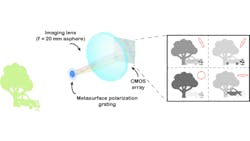Experimental filter opens the door to miniature polarization cameras
Researchers from Harvard University in their new research paper, Matrix Fourier optics enables a compact full-Stokes polarization camera (http://bit.ly/VSD-FSPC), describe the invention of a polarization filter that eliminates the need for traditional polarization optics.
Polarized light is light in which waves travel in only one, specific direction. Traditional polarization techniques used in photography and machine vision employ linear polarization filters which could be described conceptually as a slot that is rotated to only allow light on a desired polarization to pass through. Removing the undesired light waves produces a sharper image.
On-chip polarizers use wire-grids over the photodiodes of image sensors to block certain polarizations of light at four different angles, in groups of four pixels. Rather than depending on a rotating filter, on-chip polarizers allow the user to interpolate the four different pixels into a single pixel that can see several angles of polarization simultaneously. This technique can only see linear polarization.
The fundamental physical nature of polarized light is actually an ellipse, not a straight line, and so linear polarizers cannot determine the “full” polarization state of light, i.e. its angular orientation, how elliptical it is, and the degree to which the light is polarized. The new filter designed by Harvard University researchers is designed to measure the full polarization state of light by not depending on linear polarizers.
Described in the research paper as a nanoscale metasurface or a diffraction grating, the new filter is composed of rectangular pillars of titanium dioxide that are separated by around 400 nm. Rather than absorbing some polarizations of light and allowing others to pass, the pillars in the metasurface instead rearrange the light to allow for the simultaneous creation of multiple images that are combined into a single image that captures the full polarization of the light.
The result is the ability to image polarized light without special optics, which could make polarization possible on much smaller cameras than is currently possible. Smartphone cameras might be able to create polarized images, for example, if a metasurface is placed in front of the lens.
The metasurface e also eliminates the need for special image sensors with on-chip polarizers. Furthermore, the wire-grid placed over the on-chip polarizer’s photodiodes necessarily absorbs some of the light. Because the metasurface does not absorb light, it makes shorter exposure times possible compared to on-chip polarizers. The metasurface only works for monochromatic images, however, whereas on-chip polarizers can also provide color images.
Researchers believe that imaging circular polarization may assist in mapping material stress, a common use of polarization in machine vision. They also believe that the metasurface would be useful for deployment on satellites or probes where small sensors are desirable.
Related stories:
Single-photon LiDAR research accomplishes 3D imaging at extreme distances
Nuclear fusion reactor monitored by ten-camera multispectral imaging system
Vision system used to study development of memories for artificial intelligence
Share your vision-related news by contacting Dennis Scimeca, Associate Editor, Vision Systems Design
About the Author

Dennis Scimeca
Dennis Scimeca is a veteran technology journalist with expertise in interactive entertainment and virtual reality. At Vision Systems Design, Dennis covered machine vision and image processing with an eye toward leading-edge technologies and practical applications for making a better world. Currently, he is the senior editor for technology at IndustryWeek, a partner publication to Vision Systems Design.
